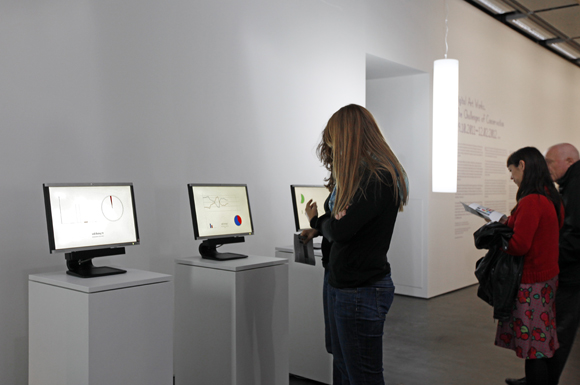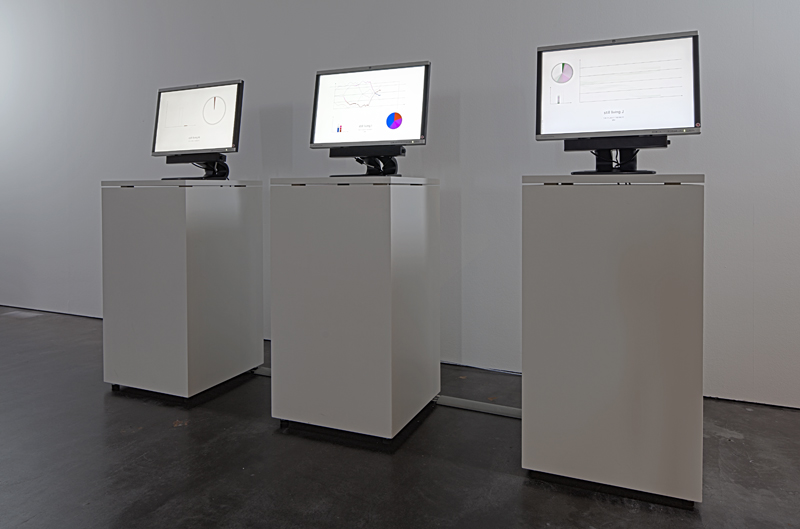|
Still living, 2006
Antoine Schmitt

still living is a series of works made by Antoine Schmitt in 2006 and consisting at present of ten elements. The Espace Multimédia Gantner has bought three of them for its collection: H, I and J. Each element is autonomous and independent of the others, with no interaction outside the work itself, apart from the date and time that appear on the computer screen, emphasizing that the program is being run in real time.
These screen installations represent the kind of graphics generated in the world of business and the stock exchange: curves, pie-charts, bar-graphs, etc. These graphics move in response to internal forces – algorithms designed by the artist.
still living H is composed of three vertical bars and a pie-chart; only the colored areas – now blue, now red – move, and most of the surfaces remain white and motionless. The slight lateral or vertical movement is very subtle. In terms of its composition, still living I presents two horizontally symmetrical curves – one blue, one red – which cross. Their slow, unpredictable movement is also visualized by bar-graphs and a pie-chart.
still living J follows the progress of a frenetic, jittery, random curve, similar to a representation of the stock exchange. Alongside the green curve, a pie-chart and smaller bar-graphs reproduce the same hectic movement.
For each item in the series still living, Antoine Schmitt presents movement of a specific kind – a central theme in his work. In order to do that, he has paid special attention to the visual aspect of the work – composition, colors, typography, the graphic elements of an industrial, capitalist formalism – in order to make it transparent. The animated graphics are a manifestation of the underlying movement. They are the form in which the artist has chosen to visualize it as a way of highlighting its different qualities. He has concentrated on giving form to random elements, but he has also created an aleatory, real-time montage of fragments of recorded movements. These movements, taken from life or imitating human activity, explain the title of the series: still lifes that have come alive through the program’s algorithms.
Antoine Schmitt is a French visual artist who since the 1990s has been using code as a working material through which to explore the idea of movement and its relationship with form. He started out as a software engineer, working on man-machine interaction and artificial intelligence, and has created a series of installations – on screen, online and in the open air – that are often minimalist. still living is one of his most formalistic pieces, and one of the most political, in terms of the way the series looks at the quantification of what is real and alive.
Conservation measures
Antoine Schmitt’s still living is a work made in 2006 that can be installed on the present generation of computers. It was designed using the Director 10 environment, and runs on the latest Mac OS X and PC operating systems. However, since Adobe, who produce it, have almost stopped developing Director, thought has had to be given to finding a conservation strategy other than migration, and beyond the environment in which still living was made.
The essence of the work is programmed movement. So that the integrity of still living can be maintained, it is essential that its program be run in real time, preserving the desired quality of this movement, rather than recording the image and the data and playing them back later.
The articulation of the movement and its relationship with the form is another important element of the work. The algorithms that create the movement and animated graphics can be dissociated when the work is updated. It is more a question of preserving the algorithm creating the movement than preserving the source code (which includes the graphic elements). If necessary, the central algorithm could be transposed into another language, as long as the movement retained the same dynamic qualities as before. And as far as the very consciously thought-through visual aspect is concerned, with its capitalist formalism, the code for that second category can also be replaced, as long as the visual result is as close as possible to the artist’s specifications for the work. He has set a number of parameters: composition (the arrangement in space of the various graphic elements), colors, typography, “label” (the title of the work and the date and time displayed by the computer), pixel clarity, texture of the work, etc.
When it comes to choosing a new programming environment, the main constraints will be to create autonomous programs that will run, and to design the graphics. A further aspect of the work’s durability is the selection of free and widely used software.
Following his experiences with works that no longer operate and would have had to be reprogrammed if they were to be shown, Antoine Schmitt now takes a work’s durability into account when he sells it. He supplies the work in the form of an executable program, with a manual of instructions for installing and presenting it and the source code for the work in the current environment, so that the purchaser will be able to maintain it.

Photos: ONUK
|